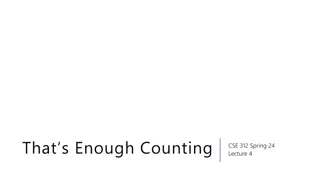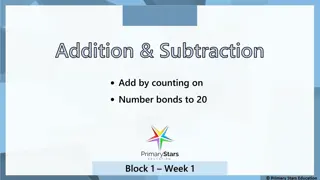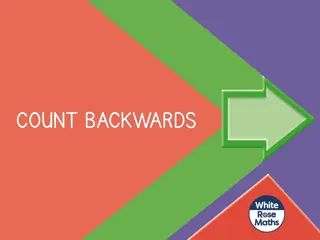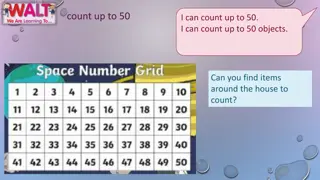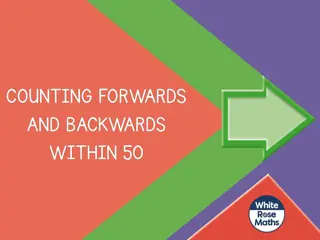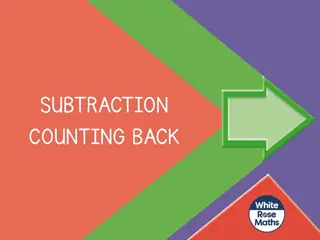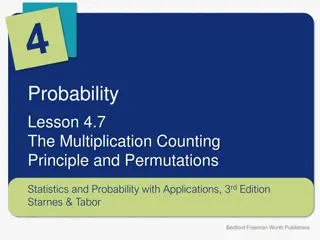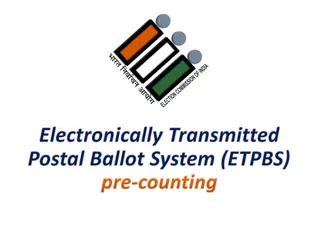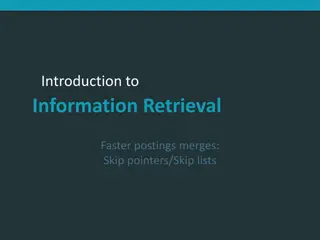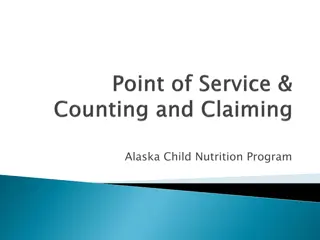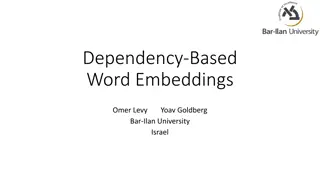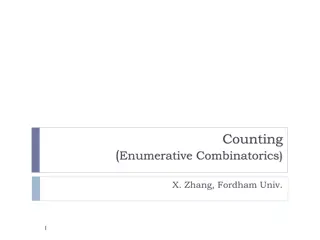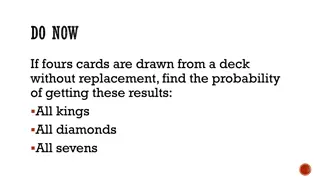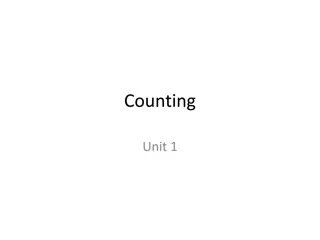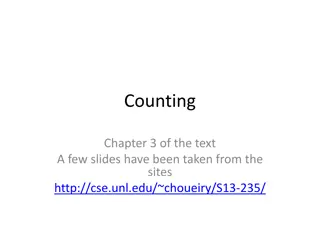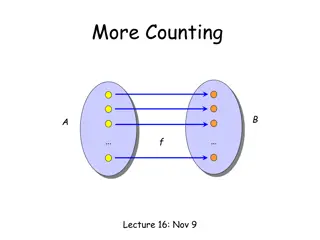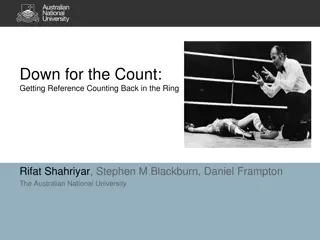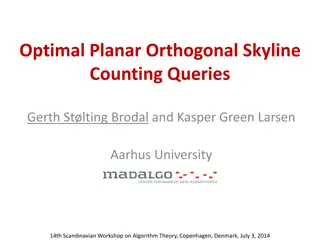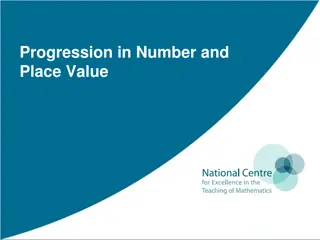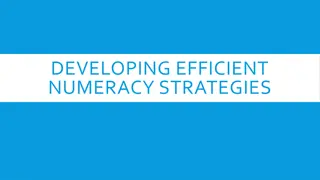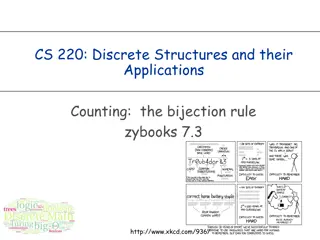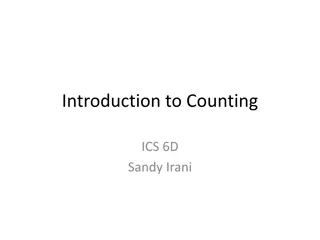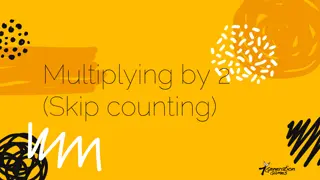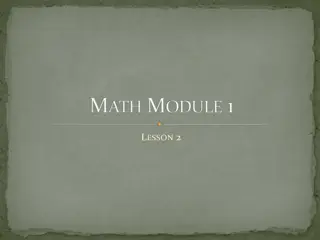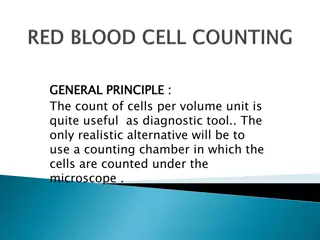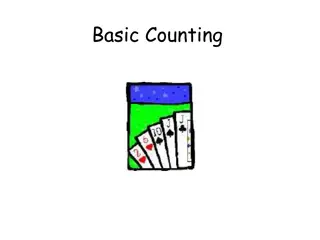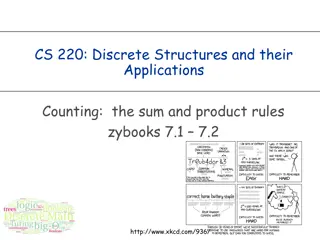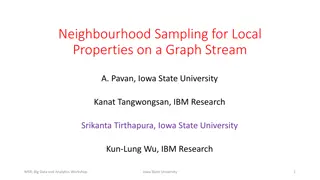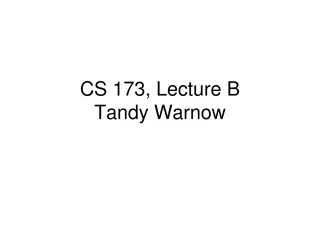Vi-CELL.BLU - Advanced Cell Counting Instrument
Vi-CELL.BLU is a cutting-edge cell counting instrument that offers faster analysis, increased resolution, and improved optical sensor technology for enhanced cell concentration and viability assessments. The device features a user-friendly interface, Trypan blue method for live cell detection, and a
1 views • 19 slides
Understanding Counting Methods in Probability
This content provides an overview of counting methods for computing probabilities, including combinations and permutations with or without replacement. It explains concepts like permutation with replacement using examples, such as finding possible combinations of letters with repetition allowed. The
0 views • 30 slides
Counting Principles and Pigeonhole Principle Explained
Explore the concepts of counting principles and the pigeonhole principle through practical examples and tips. Learn how to apply these principles to solve problems effectively. From understanding basic counting rules to the advanced pigeonhole principle, this content provides insights and guidance o
1 views • 35 slides
Addition and Subtraction: Counting On Number Bonds to 20 - Block 1 Week 1
In this lesson, students practice addition and subtraction by counting on using number bonds to 20. They learn to add by counting on and solve simple word problems involving adding and subtracting numbers. The lesson includes visual aids and reasoning exercises to reinforce understanding.
0 views • 7 slides
Counting and Number Recognition Activities
Engage in a variety of counting and number recognition activities, including identifying numbers, counting backwards, and identifying missing numbers on number tracks. These fun exercises encourage children to practice their counting skills and improve their number recognition abilities.
0 views • 13 slides
Fun Counting Activities for Kids at Home
Engage your child in interactive counting activities using everyday items found around the house. Practice counting up to 50 objects, listen and count as counters are dropped into a jar, and create whole-part models based on different scores. Keep learning fun and educational with these entertaining
0 views • 4 slides
Math Worksheet for Counting Practice
Engage in counting exercises with visual aids such as number tracks, spotting mistakes, and identifying missing numbers. Enhance counting skills forwards and backwards. Practice identifying numbers before and after given ones through interactive tasks.
0 views • 17 slides
Counting and Subtraction Activities for Elementary Math Practice
Engage in a variety of counting and subtraction exercises with visual aids such as number tracks and number lines to enhance elementary math skills. Practice counting back, subtracting numbers, and solving simple equations through hands-on activities. Strengthen your mathematical abilities with thes
0 views • 12 slides
Understanding the Multiplication Counting Principle in Probability
The Multiplication Counting Principle and Permutations play a crucial role in determining the number of possible outcomes in various processes. This lesson covers how to use factorials to count permutations, compute arrangements of individuals, and apply the multiplication counting principle to dete
0 views • 14 slides
Understanding Counters in Sequential Circuits
Counters in sequential circuits are crucial components used for counting clock cycles and measuring time intervals. They are composed of flip-flops that progress through a sequence of states based on clock pulses. This sequential circuit has no inputs other than the clock pulse and relies on its int
1 views • 22 slides
Electoral Ballot Pre-Counting Procedures
Learn the detailed steps involved in the pre-counting process of electoral ballots, including scanning forms, verifying documents, and handling discrepancies using QR code technology. Follow along to ensure accurate counting and validation of service voter documents. Get insights into the systematic
6 views • 18 slides
Understanding Sequential Counters in Digital Circuits
Sequential counters, comprised of flip-flops, are essential in digital circuits for counting clock cycles. They advance through states based on clock pulses and can measure time intervals. The circuit's output state solely depends on its present state, with transitions occurring at each clock pulse.
0 views • 22 slides
Faster Postings Merges with Skip Pointers in Information Retrieval
Enhance the speed of postings merges in information retrieval by utilizing skip pointers and skip lists strategically. Learn how to augment postings with skip pointers, optimize query processing with skips, decide where to place skips, and adopt simple heuristics for skip pointer placement.
0 views • 7 slides
Alaska Child Nutrition Program: Meal Counting & Claiming Systems
Explore the Alaska Child Nutrition Program's guidelines on acceptable point of service counting and claiming systems, along with eligibility documentation, meal counts, and reimbursement procedures. Learn about acceptable meal counting systems and the importance of maintaining accurate records for f
1 views • 37 slides
Advancements in Word Embeddings through Dependency-Based Techniques
Explore the evolution of word embeddings with a focus on dependency-based methods, showcasing innovations like Skip-Gram with Negative Sampling. Learn about Generalizing Skip-Gram and the shift towards analyzing linguistically rich embeddings using various contexts such as bag-of-words and syntactic
0 views • 39 slides
Counting Strategies and Examples in Enumerative Combinatorics
Understanding counting principles in enumerative combinatorics is essential for solving mathematical problems involving permutations and combinations. The concepts discussed include calculating probabilities, determining the number of outcomes, and applying counting rules to various scenarios such a
1 views • 69 slides
Understanding Counting Rules and Probability in Mathematics
The content delves into fundamental counting rules such as the Fundamental Counting Rule, Permutation Rule, and Combination Rule to help determine the number of possible outcomes for sequences of events. Factorial notation and permutations are also explained, along with examples to illustrate their
0 views • 24 slides
Understanding Counting Principles Through Fun Activities
Explore the concept of counting through various activities like coin flips, sandwich making, and golf orderings. Learn how to use tree diagrams for counting different outcomes and understand the multiplication principle to calculate total possible combinations. Engage with engaging examples like fli
0 views • 22 slides
Vocabulary Journey with My Dog Skip
Explore a vivid journey through words with "My Dog Skip" as the backdrop. Encounter terms such as "abject," "apathetic," "festoon," and "languid" illustrated in context. Immerse yourself in the language realm with Latin, Italian, French, and English origins bringing depth to the narrative.
0 views • 24 slides
Supporting Kids in Peru (SKIP) - A Heartfelt Journey of Aid and Challenges
Serving a low-income community in El Porvenir, Peru, SKIP provides educational support, financial aid, and parenting workshops. Founded in 2004, the organization aims to empower children and families. A dedicated volunteer shares insights from teaching, highlighting the importance of family involvem
0 views • 6 slides
Understanding Combinatorics and Counting in Mathematics
An exploration into combinatorics, focusing on arranging objects and counting possibilities. From dividing polygons to listing objects, delve into the world of counting and arrangement. Learn how counting plays a vital role in algorithms and probability, and discover the complexity it adds to variou
0 views • 117 slides
Fun with Numbers: Counting and Equations Exploration
Dive into a series of engaging activities involving counting from 1 to 30, counting backwards from 10 to 0, and exploring number relationships through simple equations such as "One more than 2 is 3" and "One more than 3 is…". Visualize the concepts through colorful images and enjoy learning about
0 views • 10 slides
Understanding Counting Rules and Bijection: Examples and Applications
Explore the concepts of counting rules and bijection through various examples, such as defining mappings for counting, power sets, and bijections between subsets and binary strings. Discover how to determine the number of ways to place chess pieces on a board without sharing rows or columns using ma
0 views • 49 slides
Reviving Reference Counting: A Comprehensive Analysis
Background garbage collection techniques like tracing and reference counting are crucial in managing memory in different settings. This article delves into the historical context, advantages, disadvantages, and challenges of reference counting in garbage collection. It presents an in-depth analysis
0 views • 35 slides
Advanced Techniques for Orthogonal Skyline Counting Queries
Advanced techniques for orthogonal skyline counting queries discuss optimal planar solutions, dividing and conquering for topmost point identification, efficient vertical slab counting, succinct data structures for prefix sums and range maxima, upper bounds on degree and multi-slab queries, as well
0 views • 11 slides
Vocabulary Study Guide for "My Dog Skip": Chapters 1-11
Delve into an engaging vocabulary study guide for the novel "My Dog Skip" covering chapters 1-11. Explore challenging words, their definitions, and origins to enhance your understanding of the text. Follow clear instructions on researching and presenting the selected words with your group members us
0 views • 28 slides
Exploring Number Sense and Place Value in Mathematics Education
This educational content delves into the progression of number sense and place value, focusing on key concepts such as counting in steps, addition and subtraction strategies, fluency in counting, and the development of mathematical language. It highlights the importance of fostering flexibility and
0 views • 19 slides
Developing Efficient Numeracy Strategies for Students
Students employ diverse methods to solve number problems, from basic counting to advanced arithmetic strategies. An early numeracy project, "Count Me In Too," outlined a learning framework describing the progression of students' strategies. The Emergent Counting Stage focuses on basic number skills,
0 views • 20 slides
Vocabulary Study Guide for "My Dog Skip" in 8th Grade ELA Class with Mrs. Henley
Explore the vocabulary of "My Dog Skip" through chapter-based word studies assigned by Mrs. Henley. Students will select challenging words, investigate their definitions, parts of speech, origins, and forms, and present their findings in a collaborative online document. Enhance comprehension and lan
0 views • 73 slides
Understanding Bijection Rule in Counting Subsets and Functions
Explore the concepts of counting subsets and functions, including injective, surjective, and bijective functions. Discover the bijection rule, which states that if there is a bijection between two finite sets, their cardinalities are equal. Learn about counting palindromes and the k-to-1 rule throug
0 views • 11 slides
Introduction to Counting Techniques in Mathematics
Explore the concept of counting in mathematics using techniques like the Product Rule and Sum Rule. Learn how to calculate the number of possible choices and selections in different scenarios, such as lunch specials, student council selections, exercise schedules, and counting strings. Understand th
0 views • 15 slides
Introduction to Multiplication by 2 and Skip Counting Activities
Explore a fun learning journey of multiplying by 2, skip counting by 2, and filling in multiplication tables for the number 2. Engage in interactive tasks like solving number sentences, drawing for skip counting, and practicing multiplication facts. Enhance mathematical skills with visual aids and p
0 views • 10 slides
Math Module 1 Lesson 2: Skip Counting, Building Tens, Multiplying and Dividing by 10
In this lesson, students will practice skip counting, building tens, and multiplying and dividing by 10. They will learn how to count by 3s and 4s, build tens, change units, and multiply/divide by 10 using visuals and examples. The lesson also includes an application problem involving sharing pencil
0 views • 18 slides
Enhancing Word Representation for Rare Words by Xiao Wenyi
This article discusses methods for improving word representation for rare words, such as the count-based Skip-gram by Mikolov and the predict-based GloVe by Pennington. It explores the concepts of Skip-gram, GloVe, and issues faced by existing models in handling rare words.
0 views • 22 slides
Hemacytometer Cell Counting Procedure
The hemacytometer cell counting method is a valuable diagnostic tool for determining the number of cells in a given volume of fluid. This process involves using a counting chamber under a microscope to calculate the cells per unit volume. By following a systematic approach, including proper dilution
0 views • 12 slides
Fundamentals of Counting Principles in Mathematics
In this lecture, we delve into basic rules for counting, including the sum rule, product rule, generalized product rule, permutations, combinations, binomial coefficients, and combinatorial proofs. We also explore the inclusion-exclusion principle with practical examples such as determining total en
0 views • 51 slides
Understanding Counting Principles in Discrete Structures
Counting serves a crucial role in algorithm design and complexity analysis, enabling us to determine program time and space complexities. This article explores counting principles such as the sum and product rules, Cartesian products, and their applications in solving simple and complex counting pro
0 views • 33 slides
Best Skip Bin Hire Services in Capalaba
If you want the Best Skip Bin Hire Services in Capalaba, visit Skip King Recycling. Skip King Recycling is your local skip hire company in Chandler, Queensland. They are a leader in waste management and rubbish removal for the residential, commercial
1 views • 6 slides
Neighbourhood Sampling for Local Properties on Graph Streams
The research explores neighbourhood sampling for local properties on graph streams, focusing on counting subgraphs within 1-neighbourhood of a vertex. It addresses the Triangle Counting Problem and explains the significance of counting triangles in various contexts such as social network analysis an
0 views • 29 slides
Combinatorial Counting and Algorithm Design Concepts
Today's lecture covers the basics of combinatorial counting and its applications in algorithm analysis. Topics include exhaustive search strategies, determining graph properties, and various counting techniques. Techniques such as counting objects and generating subsets are discussed, along with alg
0 views • 20 slides


